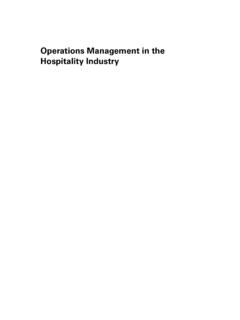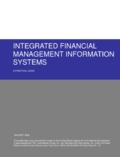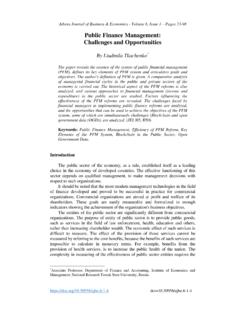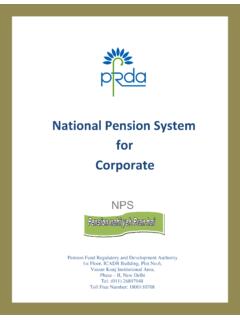Transcription of Public Procurement Fundamentals - emeraldshop
1 Public PROCUREMENTFUNDAMENTALSL essons from and for the Field(INCLUDES A SIMPLESTEP-BY-STEP GENERICPROCUREMENT MANUAL)This page intentionally left blankPUBLIC PROCUREMENTFUNDAMENTALSL essons from and for the Field(INCLUDES A SIMPLESTEP-BY-STEP GENERICPROCUREMENT MANUAL)BYNAUSHAD KHANU nited Kingdom North America JapanIndia Malaysia ChinaEmerald Publishing LimitedHoward House, Wagon Lane, Bingley BD16 1WA, UKFirst edition 2018 Copyrightr2018 Emerald Publishing LimitedReprints and permissions part of this book may be reproduced, stored in a retrievalsystem, transmitted in any form or by any means electronic,mechanical, photocopying, recording or otherwise withouteither the prior written permission of the publisher or a licencepermitting restricted copying issued in the UK by The CopyrightLicensing Agency and in the USA by The Copyright ClearanceCenter. Any opinions expressed in the chapters are those of theauthors.
2 Whilst Emerald makes every effort to ensure the qualityand accuracy of its content, Emerald makes no representationimplied or otherwise, as to the chapters suitability andapplication and disclaims any warranties, express or implied, totheir Library Cataloguing in Publication DataA catalogue record for this book is available from the BritishLibraryISBN: 978-1-78754-608-0 (Print)ISBN: 978-1-78754-605-9 (Online)ISBN: 978-1-78754-607-3 (Epub)Certificate Number 1985 ISO 14001 ISOQAR certified management System,awarded to Emerald for adherence to Environmental standard ISO 14001 the AuthorixAcknowledgmentsxiForewordxiiiLis t of Abbreviationsxv1. What Is Public Procurement : Introduction1 Pillars of Public Procurement3 Universal Principles of Procurement5 Procurement and Public finance management (PFM)8 PFM Cycle9 Procurement at National and Sub-national Levels10 Centralized, Decentralized, or Hybrid11 Political Economy of Procurement16 Economic and Social Benefits of Public Procurement16 International and Bilateral Support to PublicProcurement17 Basis of Public Procurement192.
3 Who Does It and for Whom: Organizationand Capacity21 Organization21 Beneficiaries25 Capacity25 Capacity Issues27v3. How It Is Done: Procurement cycle andProcedures29 Procurement Cycle29 Procurement Process for Goods and Works34 Prequalification (PQ)35 Open Tendering35 Restricted or Limited Tendering41 Request for Written Quotations (Shopping)42 Direct Contracting42 Consultant Selection Procedures43 Contract Negotiations and Signature53 Individual Consultants55 Single Source Selection56 Technical Services57 Bid Complaint Review Mechanism574. Contract Management635. How It Is Controlled: Risks to Procurementand Their Mitigation73 Risks73 Mitigation75 Transparency through Access to Information81 Performance Monitoring and Reporting826. New Tools of Public Procurement85 Changing World and Growing EmergingMarket Economies85 New Tools86 Framework Agreements90 Community-Based Procurement (CBP)93 Appendix A: Simple Step-By-Step GenericProcurement Manual97 Section 1: Preparation of a Procurement Plan97 Section 2: Universal Procurement Methods100viContentsSection 3: Evaluation of Bids and ConsultantProposals114 Section 4: Contract Management118 Section 5: Useful Procurement Links120 Appendix B: Additional Readings121 Index123viiContentsThispageintentionally leftblankABOUT THE AUTHORThe author served as a lead Procurement specialist at theWorld Bank (WB) at its headquarters in Washington, DCbefore his retirement in late 2011.
4 His last assignment at theWB was to support Public Procurement reform and capacitybuilding in the South Asia Region. He has a long experienceof Public Procurement reform and capacity building and theprocurement under the WB-financed development projectsin 35 countries in Eastern and Central Europe, Balkans,Caucuses, Central Asia, and South Asia. Of his 30 years atthe WB, he spent approximately 10 years of these in the clientcountries working directly with the client, , staff of govern-ment implementing agencies. He was present in EasternEuropean countries (Czechoslovakia later Czech andSlovak Republics; Hungary, Poland, Yugoslavia, etc.) duringtheir transition to market economy, and played a key role asa WB staff member in supporting these countries efforts inintroducing Public Procurement laws and regulations suitablefor the free market system. He conducted assessments of pub-lic Procurement systems in many countries, includingAlbania, Armenia, Bhutan, Croatia, Hungary, Kazakhstan,Kyrgyzstan, Poland, Slovakia, Sri Lanka, Tajikistan, Turkey,and Ukraine.
5 These assessments included recommended actionplans which led to further Public Procurement reform andcapacity building. The author managed several WB grant-funded projects in different countries in support of Public pro-curement reform and capacity building. In order to fosterixregional cooperation in Public Procurement , he initiatedregional Public Procurement forums in Central Asia and SouthAsia. In addition to making significant contributions to thepreparation of Standard Bidding Documents, such asfor Procurement of works, he also designed procurementunder emergency projects in Bosnia, Kosovo, Poland, andTurkey. Currently, the author is an international the AuthorACKNOWLEDGMENTSS incere thanks to the following knowledgeable and experi-enced colleagues for reviewing this book and for makingvaluable suggestions that significantly enriched its contents:Hiro Maruyama ( Procurement the Asian DevelopmentBank), Knut Leipold, Deepal Fernando, Nurbek Kurmanaliev,Fasliddin Rakhimov, Belita Manka, and Dilshod Karimova(PhD) ( Procurement the World Bank); Rama Krishnan,Nrpulat Daniyarov (Financial management the WorldBank); Sabri Koteci (Internal Auditor, Department forBusiness, Innovation and Skills, United Kingdom); AlmazbekDjanaliev ( Procurement OSCE, Vienna); and BakhtiyarKhamaraev ( Procurement UNDP, New York).
6 Special thanks to Nadjib Sefta and Felipe Goya, my formerprocurement managers in the South Asia Region of theWorld Bank, for their guidance in improving the content andreadability of this leftblankFOREWORDP ublic Procurement concerns and affects us all regardless ofwho we are, where we live, and what we do. Economic, social,and environmental benefits of Public programs and projects to acountry and its citizens depend very much on how Public pro-curement is managed, conducted, and controlled. These benefitsare supposed to be large as countries spend from 15 to 20percent of their gross domestic product on acquisition ofgoods, works, and services for Public programs and indicates the importance of the alignment of Public pro-curement strategies and actions to national economic, social,and environmental strategies and actions. Furthermore, publicprocurement can also serve as a useful tool for promoting inter-national and regional cooperation through trade and Procurement systems across countries are all basedin most part on the same basic principles of economy, effi-ciency, transparency, and fairness.
7 These principles haveevolved and now include value for money,fit for purpose,and integrity. Therefore, the premise of this book is the com-monalities of Public Procurement systems all over the Procurement is a complex subject. It is multidisci-plinary and cuts across all sectors of economy and society. Ithas a multitude of stakeholders with differing interests in andinfluence over Procurement . Government itself is the rulemaker, the buyer, and the overseer; private sector, the pro-ducer and the manufacturer and provider of goods, works,and services; civil society, the watch dog to ensure that thexiiibenefits of a Public project reach the people; and the people,the ultimate beneficiaries of government programs and pro-jects supported by Public Procurement exists a large amount of literature on Public pro-curement that deals with different aspects of Public procure-ment, including, among others, commercial, environmental(sustainable Procurement ), legal, and technical aspects.
8 Thisbook, however, is introductory and attempts to bringtogether these different and complex aspects of Public pro-curement in a clear and succinct, simplified, and understand-able manner. These aspects relate to Public procurementlegislative and regulatory environment; the institutionalframework and management capacity; Procurement opera-tions and market; and is expected that this book will enable the reader to graspquickly and easily the fundamental principles and mechanicsof Public Procurement ; and that this increased awareness willresult in improved performance of Public Procurement sys-tems. In addition, it is hoped that this book and its accompa-nying generic Procurement manual will be of particular helpto Public Procurement officials who more often than not haveto undertake Procurement of goods, works, and services withlittle or no training in the subject.
9 This book is also intendedfor use by private sector officials who are an integral part ofpublic word of caution for the readers: this book includes uni-versally accepted practices and procedures. Although publicprocurement legislative and/or regulatory framework in mostcountries are based more or less on the same procurementprinciples, there may be variations and departures from theseprinciples. Therefore, before applying the procedues andpracties contained in this book, it is imperative for the readerto ascertain that these are compatible with the national pro-curement laws and OF ABBREVIATIONSADBA sian Development BankCDDC ommunity-driven DevelopmentCBPC ommunity-based Procuremente-GPElectronic Government ProcurementEUEuropean CommissionFIDICI nternational Federation of ConsultingEngineersGACG overnance and Anti-corruptionGPAG overnment Procurement AgreementITInformation TechnologyMDBM ultilateral Development BanksM&EMonitoring and EvaluationMTD/SBD Model Tender Documents/Standard BiddingDocumentsMOFM inistry of FinanceOECDO rganization for Economic Cooperation andDevelopmentOSCEO rganization for Security and Cooperation inEuropePPAP ublic Procurement AgencyPCProcurement CommitteexvPEProcuring EntityPPProcurement PlanPPL/APublic Procurement Law/ActPPRP ublic Procurement RegulationPPPP ublic Private
10 PartnershipPQPre-qualificationRFPR equest for ProposalTECT ender (Bid) Evaluation CommitteeUNCITRAL United Nations Commission on InternationalTrade LawUNCACU nited Nations Convention against CorruptionWBWorld BankxviList of AbbreviationsCHAPTER 1 WHAT IS Public Procurement :INTRODUCTIONP ublic Procurement is an important government systemfor spending Public money on acquisition of goods, works,and services needed for Public programs and comprises: (i) preparation of annual budgetwhen government agencies have to estimate their needs,(ii) Procurement planning following budgetary allocation,and (iii) execution of Procurement plans. Procurement plansare implemented using a Procurement cycle that includes ten-dering or bidding, contract award, and contract main objective of these activities is delivery of qualityand timely services to citizens through Public programs andprojects, implementation of which is supported by Procurement activity of the government begins withthe identification of inputs needed for implementing publicprograms and projects; categorization of these inputs intogoods, works, and services; estimation of their costs; selectionof suppliers; award of contract; contract management ;1delivery and receipt of goods, works, and services; theirefficient and effective utilization.







